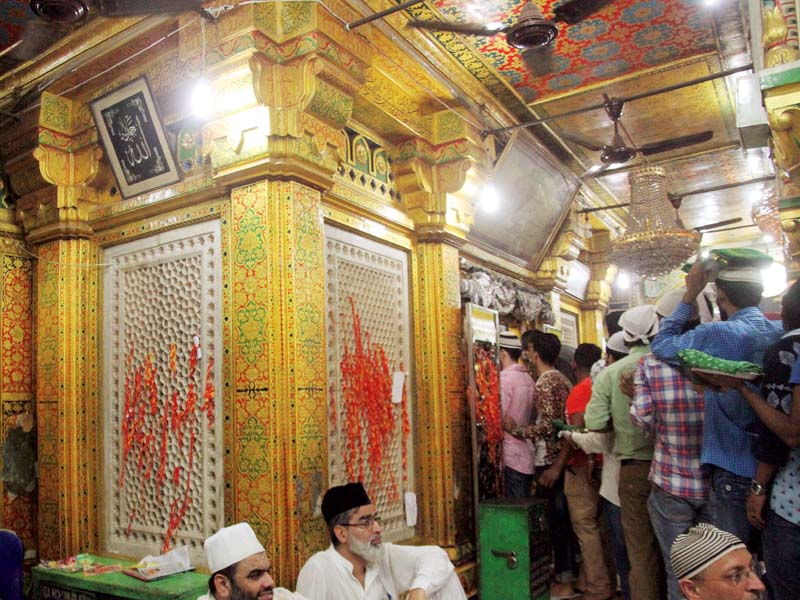
Devotees continue to throng at the entrance of the compound of Nizamuddin Auliya’s shrine in the heart of India’s capital amid qawwals preparing to get going. The visitors include Muslims sporting beards, Hindus with a tilak on their foreheads, Sikhs donning their traditional turbans and even Christians; a testament to how the shrine transcends ethnic and religious divide. Even foreigners can be seen at ease as there’s no gawking. Attendees are in a world of their own – a world that rests at the footsteps of Nizamuddin and his disciple Ameer Khusru.
“The Sufis preached tolerance. This is why you’ll see followers of every faith here,” caretaker Syed Nizam Ali Nizami proclaims. His point is validated by a Hindu driver Naveen, who is also among the crowd. “I frequently visit to pay my respects to the saint. My parents had been doing this for years. We hold it in regard like a place of worship,” says the 40-year-old.
Read: Travel diaries: In the presence of Nizamuddin Auliya

Under the ‘Aalam-e-Khusrau’ project, budding singers are trained by maestros to hone their talent. PHOTOS: ATHAR KHAN/EXPRESS
Existential threat
Commercialisation has impacted traditional qawwali, which finds itself in a race against time. “The qawwali being sung today has deviated from the roots significantly,” maintains qawwal Chand Nizami. He believes the older generation itself has lost interest in the form of music and that all the newer generation cares about is the contemporary product.
Keeping the dilemma in mind, the Aga Khan Trust for Culture initiated a project titled ‘Aalam-e-Khusrau’ back in 2011. Preservation of the art form is no easy feat. “It’s diminishing bit by bit. We’ve tried to document the methods and innovations of Khusru still practised by the qawwals,” says Ditti Ray, who has dedicated his energies towards the cause. Ditti says the five gharanas of Delhi’s qawwals were approached so that their devotional songs could be recorded. “These also include the Atroli and Jaipur gharanas.” She adds Khusru’s classical and folk creations are also on the list. “We reached out to far-off places, such as Jaipur, Agra and Kashmir for the project.”

Project members even approached popular Pakistani qawwal Fareed Ayaz in this regard. The trust provided for all the singers who sung ragas ascribed to Khusru. “Saazgiri is one of the very rare ragas of Khusru. It was sung by Ustad Shujjat Hussain Khan at one of the concerts,” adds project member Ditti, saying that one CD has already been released by the trust. They put together concerts of both the Indian and Pakistani qawwals frequently. “Pakistani qawwals have quite a following here. Every concert has a minimum of one or two invited. They draw crowds in thousands,” Ditti says. The exploits of the project can be accessed at aalamekhusrau.com.
Passing on the mantle
Preservation is only a stepping stone. The project also aims to pass the mantle on to the newer generations. “Most of these qawwals knew Persian very well but they did little to teach their children the same way due to bleak monetary prospects.”
Ditti says budding singers are handpicked and then sent to some of these maestros for formal training under the Shagirdi programme. Chand is one of those who conduct these sessions. Perched upon a cushion in the small rehearsal room in his house, he invites these students every week. “It’s encouraging to see them take interest. Qawwali was created to last forever and will not disappear as long as people like these are alive,” says Chand, his tone brimming with pride. His claims seem justified given the amount of traffic generated by the website and the mobile app.

On my way back from the congested Basti Nizamuddin, I find boys in the narrow streets listening to music on their smart phones. As Bollywood dominates their lives at large, the element of Khusru also seems to occupy some of their sensibilities. “I’m a huge fan of Khusru. His poetry is still relevant,” says Rashid Siddiqui as he shows me the Aalam-e-Khusrau app on his phone.
The writer is a staff correspondent who visited India as part of a journalism exchange programme organised by the East-West Center.
Published in The Express Tribune, October 3rd, 2015.
Like Life & Style on Facebook, follow @ETLifeandStyle on Twitter for the latest in fashion, gossip and entertainment.



1731570357-0/elon-musk-(1)1731570357-0-165x106.webp)
-(1)1717678110-0/Kendrick-(1)-(1)1717678110-0-165x106.webp)





1627551707-01732470336-0/ipiccy_image-(15)1627551707-01732470336-0-270x192.webp)






COMMENTS
Comments are moderated and generally will be posted if they are on-topic and not abusive.
For more information, please see our Comments FAQ